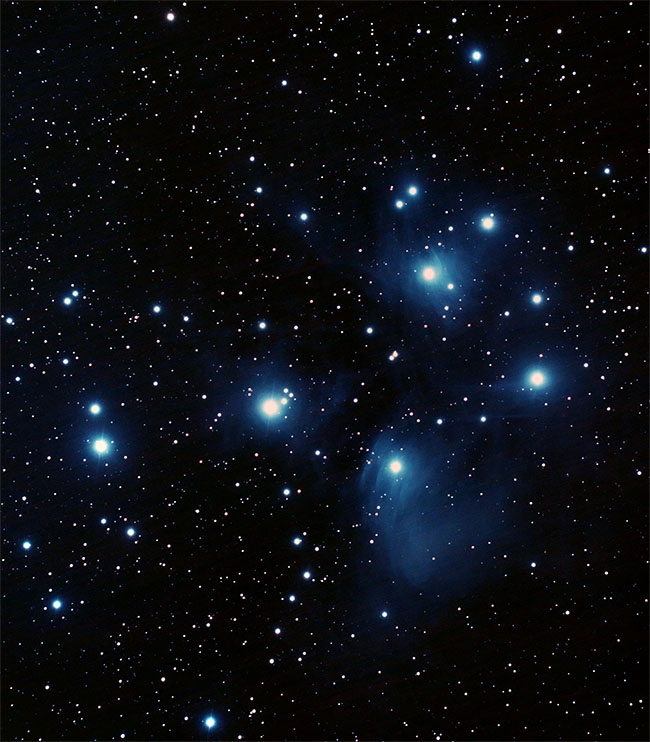M45 - The Pleiades
 This night I was visiting my girlfriend and her parents. We were celebrating "första advent" (Advent sunday) with their friends. I knew the weather was going to be pretty good so I couldn't resist taking my portable equipment with me to try to do some photography. My original intention was to image the triangulum galaxy (M33), but as I forgot to take my finder with me I knew this was going to be a hard task. Instead I decided to go for two open clusters; "the double cluster" and "the pleiades". In between the dinner/eating I went out sometimes to set up the telescope for some imaging. The air was very humid this night (95% humidity) so dew started forming instantly. I had to remove the dew with a hair-dryer all the time. This image of M45 turned out a lot better than the last try I think. After one hour of imaging M45 the clouds rolled in, I was not too surprised about that.
This night I was visiting my girlfriend and her parents. We were celebrating "första advent" (Advent sunday) with their friends. I knew the weather was going to be pretty good so I couldn't resist taking my portable equipment with me to try to do some photography. My original intention was to image the triangulum galaxy (M33), but as I forgot to take my finder with me I knew this was going to be a hard task. Instead I decided to go for two open clusters; "the double cluster" and "the pleiades". In between the dinner/eating I went out sometimes to set up the telescope for some imaging. The air was very humid this night (95% humidity) so dew started forming instantly. I had to remove the dew with a hair-dryer all the time. This image of M45 turned out a lot better than the last try I think. After one hour of imaging M45 the clouds rolled in, I was not too surprised about that. 
 An open cluster is a group of up to a few thousand stars that were formed from the same giant molecular cloud and have roughly the same age. More than 1,100 open clusters have been discovered within the Milky Way Galaxy, and many more are thought to exist. They are loosely bound to each other by mutual gravitational attraction and become disrupted by close encounters with other clusters and clouds of gas as they orbit the galactic center, resulting in a migration to the main body of the galaxy as well as a loss of cluster members through internal close encounters. Open clusters generally survive for a few hundred million years. In contrast, the more massive globular clusters of stars exert a stronger gravitational attraction on their members, and can survive for many billions of years.
An open cluster is a group of up to a few thousand stars that were formed from the same giant molecular cloud and have roughly the same age. More than 1,100 open clusters have been discovered within the Milky Way Galaxy, and many more are thought to exist. They are loosely bound to each other by mutual gravitational attraction and become disrupted by close encounters with other clusters and clouds of gas as they orbit the galactic center, resulting in a migration to the main body of the galaxy as well as a loss of cluster members through internal close encounters. Open clusters generally survive for a few hundred million years. In contrast, the more massive globular clusters of stars exert a stronger gravitational attraction on their members, and can survive for many billions of years. ― source and more information wikipedia
― source and more information wikipedia
Date: 2013-11-30
Location: Haninge, Sweden
Temperature: -2 °C
Telescope: William-Optics Megrez 88FD
Camera: Canon 600D
ISO: 1600
Exposure time: 180 X 25 sec
Reducer/flattener: William-Optics 0.8X reducer/flattener (P-FLAT-F6)
Filter: Astronomik CLS
Other info: Used manfrotto 055 tripod.
Processing: Processed in Photoshop CS6.




 2013-11-30
2013-11-30 